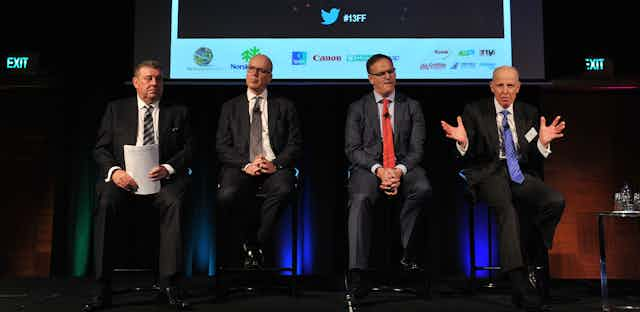In the past five years, APN News and Media and Fairfax Media have laid off masses of editorial workers as a part of their “digital first” strategies. They have integrated their newsrooms, cut down print editions, and diversified their advertising income streams to sponsored content and listing services. Despite such efforts, their digital business models have not quite worked.
In this context it is not surprising that APN News and Media and Fairfax Media are planning to spin-off their New Zealand businesses by merging them. The companies are not alone. The newspaper industry is consolidating and converging outside Australasia. In the United States, Gannett is currently trying to buy Tribune Publishing for US$815 million. In Italy, La Repubblica and La Stampa newspapers are merging to create “a leading European group in the daily and digital information industry”. This, according to the companies, is the most significant merger in Italy’s newspaper industry “since the digital revolution”.
New Zealand Broadcasting Minister Amy Adams considers the proposed merger between AP and Fairfax as natural evolution, brought upon by convergence in the telecommunication and media sectors. She says:
“The distinctions between print, radio, television and online news are fading. Generally, digital convergence is giving New Zealanders a greater access to content than ever before.”
Mergers make business sense
There is a certain business logic to media mergers and takeovers. They are primarily done to cut cost, boost revenue and to satisfy long suffering shareholders. On Wednesday, Fairfax chief executive officer Greg Hywood said the proposed merger was “an important opportunity for all of our shareholders”. Similarly, APN chief executive officer Ciaran Davis commented that “the merger of NZME and Fairfax’s NZ business provides an exciting opportunity for our shareholders”.
Under the plan, APN would first demerge NZME (New Zealand Media and Entertainment) and then list the company on the New Zealand and Australian stock exchanges. After that, Fairfax’s New Zealand businesses would be folded into the new company. NZME’s main media assets include the NZ Herald and Radio Network, which runs multiple commercial radio stations in the country. Fairfax owns newspapers such as The Dominion Post (Wellington) and The Press (Christchurch) as well as the online news outlet Stuff.
Both companies have seen their New Zealand revenues and profit dropping. APN’s investor statement notes that the “New Zealand market conditions have been challenging and revenues were down 10%” on the first quarter of 2016. Similarly, in the first six months of 2016, Fairfax’s revenue in New Zealand declined 9% in local currency terms, and its profit was down 12%.
By merging their New Zealand businesses, APN and Fairfax hope to boost their revenue and profit, but this can only happen by cutting more costs. The companies are bound to achieve some savings by shedding jobs from their combined workforce of 3,000 even when redundancies are not inexpensive. The former NZ Herald editor-in-chief Tim Murphy estimates that combining the two businesses might cost 750 jobs.
Defensive against the global players
Fairfax’s and APN’s proposed deal is a defensive move as they compete for the local and global advertising dollar. The merger is all about audience reach and advertising money. Larger audience means potentially more clicks and views, and that is what matters to advertisers. Or so they say.
Simon Tong, the Managing Director of Fairfax NZ says that “the depth and breadth of the combined business would be a win for audiences, and also enable us to create innovative solutions for advertisers based on the best of both of us”.
News publishers are increasingly joining forces against search engines such as Google and social media companies such as Facebook to defend their advertising revenues. In New Zealand, Fairfax Media, MediaWorks, NZME and TVNZ have already formed a local advertising exchange service KPEX to defend their advertising share in the local market.
More recently, four large American newspaper groups including Gannet and Tribune Publishing have created a new national advertising network which is focusing on digital platforms. In Europe, The Guardian, CNN International, Financial Times, Reuters and The Economist have formed The Pangea Alliance, a joint sales effort, to boost and protect their advertising income.
What is local, and what is global?
According to JMAD New Zealand Media Ownership Report 2015, Fairfax and APN have a duopoly in the New Zealand print newspaper market, and they dominate in online news. Additionally, APN has a duopoly in commercial radio with MediaWorks. As the new company would have a near monopoly in the newspaper market, it is not surprising that the deal requires approval from the Commerce Commission.
APN and Fairfax believe there is nothing anti-competitive in their deal, because they operate in the global media environment, and therefore the merger would not limit readers’ access to news. This is where their logic fails. What about the access to local news?
Taking one media company out of market clearly limits the readers’ choice, and if the merged company puts up paywalls, readers will be left with even more restricted access to local news content. The duopoly structure of the two companies has so far limited the introduction of digital subscriptions to New Zealand readers, but they are more than likely to launch paywalls if the merger gets a clearance.
The Coalition for Better Broadcasting, which advocates public interest journalism in New Zealand, has warned the proposed merger “would effectively create a monopoly with too much market power in the newspaper sector”. According to the coalition, the new media company would “have no incentive to maintain competing publications” in the same regions and cities “probably leading to closures of smaller titles and reducing diversity, local representation and consumer choice”.

